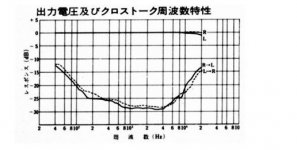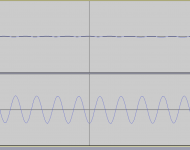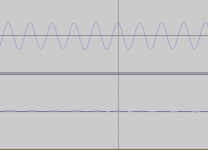So a new postulate to test against reality:
If crosstalk is coherent and in antiphase to the stimulus on both L&R channels, or if crosstalk is not coherent, then mistracing is the dominant cause.
If crosstalk is coherent and in antiphase to the stimulus on only one channel, then azimuth error is the dominant cause.
Reasonable ?!?
LD
If crosstalk is coherent and in antiphase to the stimulus on both L&R channels, or if crosstalk is not coherent, then mistracing is the dominant cause.
If crosstalk is coherent and in antiphase to the stimulus on only one channel, then azimuth error is the dominant cause.
Reasonable ?!?
LD
Can you assume that the mistracing follows a sinusoidal curve if you have such a test tone? For all I know the level and phase is clearly related to azimuth setting but one could also test the impact on VTF + AS force and possibility that the stylus loose contact.I believe this might be the assumption which is wrong, and explain what we see.
Consider that it is the plain (unmodulated) wall that is not in contact with the stylus, whilst the other(modulated) wall is tracing the sine tone in contact with the stylus albeit at the wrong 'height'. Stylus is mistracing and riding up the modulated wall and is not in contact with the plain (unmodulated) wall.
The riding motion is free in the plain of the unmodulated wall: effectively the stylus is in free air in that plain and can ride at an arbitrary height. Then its motion need not have any certain phase relationship with the modulations on the modulated wall, though one would think it generally would, I suppose. But it is free in one plain, and could have any motion depending on what else is going on.
LD
So a new postulate to test against reality:
If crosstalk is coherent and in antiphase to the stimulus on both L&R channels, or if crosstalk is not coherent, then mistracing is the dominant cause.
If crosstalk is coherent and in antiphase to the stimulus on only one channel, then azimuth error is the dominant cause.
Reasonable ?!?
LD
I have not given it so much thought but I think it holds true but only if the groove and generator has perfect +/- 45 deg. If you have this an azimuth change of the coils to 44/46 degrees relative to the groove will give one antiphase signal and one in phase. However if the coils are in 44/44degrees you will never achive a null.
Thanks, ThomasA.
I suppose there are two theoretical sources of crosstalk: geometric error due to azimuth in the broadest sense, and mistracing in its broadest sense.
I think azimuth and mistracing can, in principle, be told apart by relative phases of both channels in turn. But I don't know in practice which is dominant.
If coils or grooves make less than 90 deg though, say 44/44 then at perfect alignment, I still think the causes can be seoerated by the same phase principle.
LD
I suppose there are two theoretical sources of crosstalk: geometric error due to azimuth in the broadest sense, and mistracing in its broadest sense.
I think azimuth and mistracing can, in principle, be told apart by relative phases of both channels in turn. But I don't know in practice which is dominant.
If coils or grooves make less than 90 deg though, say 44/44 then at perfect alignment, I still think the causes can be seoerated by the same phase principle.
LD
Thanks, ThomasA.
I suppose there are two theoretical sources of crosstalk: geometric error due to azimuth in the broadest sense, and mistracing in its broadest sense.
I think azimuth and mistracing can, in principle, be told apart by relative phases of both channels in turn. But I don't know in practice which is dominant.
If coils or grooves make less than 90 deg though, say 44/44 then at perfect alignment, I still think the causes can be seoerated by the same phase principle.
LD
LD,
whiteout knowing the truth of my records, the Ortofon shows in general the best of the bunch. I have yet to collect the new test record to finalise some data. Josh have some notes that are interesting though which is related to the records cut principle. It is related to the cutter used but I have not given it too much thought. Josh pages have so much information so you find something new every time you look there.
See the headline "Variance between two structures" in his VTA page:
VTA
Wonder if Josh is around on this site?
Yes Yosh's resources really are a treasure. I corresponded with him perhaps 5 years ago now, and found him very kind and generous.
IF I am right about mistracing being a factor in crosstalk, then test tone level and position on the record would be a factor, as well as frequency. This might explain variation in results between test records?
LD
IF I am right about mistracing being a factor in crosstalk, then test tone level and position on the record would be a factor, as well as frequency. This might explain variation in results between test records?
LD
Last edited:
Another data point. This is from the spec sheet of the Denon DL-107, a cartridge that intrigued me enough to pick one up to add to the pile to try out. Now this is state of the art 1969 and there is no details on how they measured the cross talk, but at least a diagram rather than a couple of points.
Between 150Hz and 8kHz it's probably as good as it gets for a conical. outside those limits there is something the inveterate fiddler might want to consider adjusting.
Between 150Hz and 8kHz it's probably as good as it gets for a conical. outside those limits there is something the inveterate fiddler might want to consider adjusting.
Attachments
Thanks, Bill.Another data point. This is from the spec sheet of the Denon DL-107, a cartridge that intrigued me enough to pick one up to add to the pile to try out. Now this is state of the art 1969 and there is no details on how they measured the cross talk, but at least a diagram rather than a couple of points.
Between 150Hz and 8kHz it's probably as good as it gets for a conical. outside those limits there is something the inveterate fiddler might want to consider adjusting.
Interesting that the shape of the crosstalk curve versus f follows the general trackability performance versus f curve, don't you think? Well, the inverse curve you know what I mean.
LD
Hmm. I suppose crosstalk test records would generally be recorded at a strong level so as to make measuring the unmodulated channel possible back in the days before fft made it a doddle?
However, that might predetermine that traceability is typically the limiting factor in such tests. Which would also be true in programme material, but only at high levels.
Then crosstalk performance would be level sensitive at any given f. Well, above a certain floor set by azimuth/geometry.
Edit: real programme material crosstalk performance might far exceed such measured performance, especially for low levels.
LD
However, that might predetermine that traceability is typically the limiting factor in such tests. Which would also be true in programme material, but only at high levels.
Then crosstalk performance would be level sensitive at any given f. Well, above a certain floor set by azimuth/geometry.
Edit: real programme material crosstalk performance might far exceed such measured performance, especially for low levels.
LD
Last edited:
Now you mention it, it does. That might explain why Thomas is getting such good numbers off his cartridge.
It is the cartridge that surpassed my OM40 as well as the Shure original MR in terms of lower distortion, better channel balance and lower crosstalk. It is a bit resonant 10-20 kHz with standard loading but I managed to tame it with some special loading. The resonance is perhaps one reason why it cannot keep up with the excellent x-talk above 10 kHz.
The probable reason for it good spec is that I cannot find any flaws in the cantilever and stylus mounting. It is just perfect and most probably JICO have or had a very skilled person that made those stylii.
The sapphire version of this stylus did not measure or sound as good as my two boron variants, nor did the original Shure MR stylus. The Shure also showed irregularities in diamond tip and had a slightly skewed cantilever. The same goes with my Ortofon OM10 and OM40 with respect to cantilever mounting.
I suspect that the stylus/cantilever comes as a single assembly from Namiki.
I was mulling on the ride home. There are 3 of us who have a good x-section of Ortofon OM series stylii so between us we should be able to get several sets of comparative measurements of the same generator with different trackability.
I was mulling on the ride home. There are 3 of us who have a good x-section of Ortofon OM series stylii so between us we should be able to get several sets of comparative measurements of the same generator with different trackability.
I suspect that the stylus/cantilever comes as a single assembly from Namiki.
I was mulling on the ride home. There are 3 of us who have a good x-section of Ortofon OM series stylii so between us we should be able to get several sets of comparative measurements of the same generator with different trackability.
Yes, it is doable. Preferably using a test record that we have in common. I am picking up the Elipson tomorrow and will do some initial test and now have six of test records. The Orfoton and The Ultimate Analogue Test LP are the best of them, even if flaws exist. Tacet has some interesting tracks as do Hifi News test record, that the other ones does not have, but quality varies a bit more than the first ones. Elipson will have yet other test tracks that are usable, but quality is unknown at the moment.
These are my test records:
Shure TTR 101
Shure TTR 103
Decca SXL 2057
Decca SKL 5346
NEC ES-1008
Hi Fi Sound HFS75
Decca SKL 4861
The only one with a crosstalk f sweep is Decca SXL2057, which is at 0dB = 1cm/s@1kHz and it has RIAA switched on. This means at hf, say 10Khz, the level is quite hot, about 450G acceleration even though it's on an outer track.
Not much real programme content exceeds that level of acceleration stress, based on my measurements some years back. It's approximately the peak level on many LPs.
Although on a good cartridge 500G won't mistrack, I suspect many cartridges would mistrace slightly - it only takes about 750nm of gap between stylus and one wall to hit -20dB of crosstalk, in principle. Riding up the curve, in this case at hf. Or something bending......
LD
Shure TTR 101
Shure TTR 103
Decca SXL 2057
Decca SKL 5346
NEC ES-1008
Hi Fi Sound HFS75
Decca SKL 4861
The only one with a crosstalk f sweep is Decca SXL2057, which is at 0dB = 1cm/s@1kHz and it has RIAA switched on. This means at hf, say 10Khz, the level is quite hot, about 450G acceleration even though it's on an outer track.
Not much real programme content exceeds that level of acceleration stress, based on my measurements some years back. It's approximately the peak level on many LPs.
Although on a good cartridge 500G won't mistrack, I suspect many cartridges would mistrace slightly - it only takes about 750nm of gap between stylus and one wall to hit -20dB of crosstalk, in principle. Riding up the curve, in this case at hf. Or something bending......
LD
I need to check what I have. I did get a handful recently but not checked them in detail. Question. Whilst it would be nice to compare records, for the case that we are looking at (delta in cross-talk between lowest and highest end models) does it matter as the delta should be the same unless there are gross errors in the cutting of the test record?
I predict that level of the test tone, and its location on the record would dominate.does it matter as the delta should be the same unless there are gross errors in the cutting of the test record?
One might predict that, of the crosstalk test records at 1kHz, those appearing to have least crosstalk would be those with lowest recorded level....
It's counter-intuitive though. One would always instinctively try for a strong signal to make measuring easy. But these days we can fish 1kHz out of the noise mire if necessary with fft, very easily, where oscilloscopes fear to tread
LD
Been doing some work today, levelling the turntable more precisely and did some adjustment of the SAS stylus damper so now it is fully functional. I raised the VTF to 1.4 g and use the damper on from now on.
Recorded the Elipson test record and the signals appear to be rather good quality. However, the record suffers from rather much pops/clicks. I cannot understand why my test records suffer more from pops/clicks than the music LPs.
Yet to fix: fine-tune azimuth, fine adjust speed and fix a grounding issue in my RIAA stage. The 1 kHz left-right test on the Elipson record shows that L->R crosstalk is in phase, while the R->L is out of phase. Now, someone can give some clues if I need to adjust the cartridge clockwise or counter-clockwise? I have forgotten which way it is based on the phase figures.
After this I will do some more extensive recording and comparisons of the test records with respect to crosstalk.
Recorded the Elipson test record and the signals appear to be rather good quality. However, the record suffers from rather much pops/clicks. I cannot understand why my test records suffer more from pops/clicks than the music LPs.
Yet to fix: fine-tune azimuth, fine adjust speed and fix a grounding issue in my RIAA stage. The 1 kHz left-right test on the Elipson record shows that L->R crosstalk is in phase, while the R->L is out of phase. Now, someone can give some clues if I need to adjust the cartridge clockwise or counter-clockwise? I have forgotten which way it is based on the phase figures.
After this I will do some more extensive recording and comparisons of the test records with respect to crosstalk.
Attachments
I wrote up some testing of crosstalk and azimuth if someone is interested.
Dropbox - Azimuth adjustment.pdf
Dropbox - Azimuth adjustment.pdf
Very impressive method and results, ThomasA - thank you very much for this and writing it up.
I think it shows that when crosstalk is in opposite phase in L>R and R>L tests, then coil azimuth dominates and can be improved by adjustment. At the optimal coil azimuth setting, any other phase combination can result, and perhaps the cause of this remnant is unwanted stylus/cantilever/generator motion or in the cutting process? But it seems a good way to determine when the optimal setting is achieved, and working out which way to rotate the cart.
Crosstalk remnant seems to be about -35dB to -30dB, consistent with the best available results claimed by lathe trolls elsewhere.
Do you know what level the Epsilon test track is recorded at, ThomasA?
Thx again.
LD
I think it shows that when crosstalk is in opposite phase in L>R and R>L tests, then coil azimuth dominates and can be improved by adjustment. At the optimal coil azimuth setting, any other phase combination can result, and perhaps the cause of this remnant is unwanted stylus/cantilever/generator motion or in the cutting process? But it seems a good way to determine when the optimal setting is achieved, and working out which way to rotate the cart.
Crosstalk remnant seems to be about -35dB to -30dB, consistent with the best available results claimed by lathe trolls elsewhere.
Do you know what level the Epsilon test track is recorded at, ThomasA?
Thx again.
LD
Last edited:
- Status
- This old topic is closed. If you want to reopen this topic, contact a moderator using the "Report Post" button.
- Home
- Source & Line
- Analogue Source
- Cross-talk measurements vs frequency?


